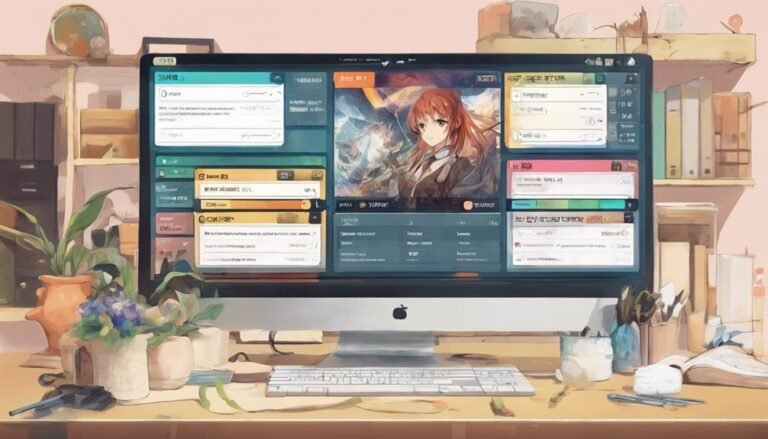How Do I Design Courses for Diverse Learning Styles and Preferences?
To design courses for diverse learning styles, cater to visual learners with graphs, videos, and interactive visuals. For kinesthetic learners, incorporate hands-on activities and engaging experiences. Use varied methods like group discussions, simulations, and quizzes to appeal to different preferences. Enhance memory retention by engaging all senses through multisensory techniques. Varied assessment approaches, flexible deadlines, and alternative assignments accommodate diverse strengths and paces. Leverage technology like multimedia resources and virtual reality for interactive learning. Create a supportive environment with peer feedback, clear communication, and self-directed resources. Differentiated instruction recognizes individual preferences for inclusive learning. Optimizing these strategies maximizes student engagement and learning success.
Key Takeaways
- Understand diverse learning styles to tailor content delivery.
- Incorporate visual aids for visual learners and interactive activities for kinesthetic learners.
- Utilize multisensory techniques to engage all senses for enhanced learning.
- Offer varied assessment approaches to accommodate different preferences and strengths.
- Leverage technology for interactive and engaging learning experiences.
Understanding Diverse Learning Styles
To effectively tailor educational strategies, it's essential to comprehend the various learning styles that individuals exhibit. Understanding learning styles such as visual learners and kinesthetic learners is vital for designing courses that cater to diverse preferences.
Visual learners typically grasp information better through visual aids like graphs, diagrams, or videos. Incorporating visual elements into your course material can greatly enhance the learning experience for these students.
On the other hand, kinesthetic learners learn best through hands-on activities and experiences. Providing opportunities for interactive learning, such as simulations, experiments, or group projects, can greatly benefit kinesthetic learners in understanding and retaining course content.
Adapting Content Delivery Methods
Effective adaptation of content delivery methods in educational settings requires a strategic alignment with diverse learning styles to optimize student engagement and comprehension. To cater to various preferences, incorporating interactive presentations, hands-on activities, visual aids, and group discussions can greatly enhance the learning experience. Research suggests that utilizing a mix of these methods can appeal to a broader range of learners, promoting active participation and knowledge retention.
| Interactive Presentations | Visual Aids | Group Discussions |
|---|---|---|
| Engage learners through interactive tools like quizzes or simulations. | Enhance understanding with visual representations such as diagrams or charts. | Encourage collaborative learning and critical thinking through group discussions. |
| Create a dynamic learning environment that stimulates curiosity and exploration. | Cater to visual learners by providing clear and concise visual cues. | Foster communication skills and peer-to-peer learning. |
| Promote real-time feedback and assessment of student comprehension. | Aid in memory retention and information recall. | Allow students to share diverse perspectives and learn from each other. |
Incorporating Multisensory Techniques
To effectively incorporate multisensory techniques into your courses, consider engaging all senses to provide varied sensory experiences. Research suggests that integrating visuals, auditory cues, and hands-on activities can enhance learning outcomes by catering to different learning styles.
Engaging All Senses
Incorporating multisensory techniques enhances the learning experience by stimulating multiple senses simultaneously, fostering deeper engagement and retention of course material. When designing courses, incorporating sensory immersion through interactive activities and promoting hands-on exploration for experiential learning can greatly benefit learners. Research shows that engaging all senses during the learning process can lead to better memory retention and understanding of concepts. By combining visual, auditory, kinesthetic, olfactory, and gustatory stimuli, educators can create a more immersive and impactful learning environment. This approach caters to various learning styles, ensuring that students with different preferences can effectively absorb and retain information. Below is a table illustrating the benefits of engaging all senses in the learning process:
| Benefits of Engaging All Senses |
|---|
| Enhanced memory retention |
| Improved concept understanding |
| Increased engagement |
| Catering to diverse learning styles |
| Stimulating interactive learning |
Varied Sensory Experiences
To enhance course design for diverse learning styles, it's essential to explore the implementation of varied sensory experiences, incorporating multisensory techniques to promote deeper engagement and knowledge retention among learners.
Sensory integration plays a vital role in creating interactive environments that cater to different learning preferences. By incorporating hands-on activities, such as experiments or simulations, educators can provide tactile experiences that benefit kinesthetic learners. Visual aids, like diagrams, charts, or videos, appeal to visual learners, aiding in information processing and understanding.
Research suggests that engaging multiple senses simultaneously enhances memory encoding and retrieval, making learning more effective and enjoyable. By incorporating varied sensory experiences, courses become more inclusive, accommodating a wider range of learning styles and preferences.
Providing Varied Assessment Options
Implementing a range of assessment options enhances the inclusivity and effectiveness of course evaluations for diverse learning styles. By offering alternative assignments, such as presentations, written papers, or hands-on projects, you can cater to varying preferences and strengths.
Providing individualized feedback tailored to each student's learning style can further enhance their understanding and motivation. Flexible deadlines allow students to manage their time effectively, reducing stress and accommodating different learning paces.
Creative projects, like multimedia presentations or group collaborations, can engage visual, auditory, and kinesthetic learners simultaneously, fostering a deeper understanding of the material. Research suggests that offering varied assessment options not only accommodates diverse learning styles but also promotes critical thinking and creativity.
This approach encourages students to demonstrate their knowledge and skills in ways that resonate with their individual preferences, leading to a more thorough and fair evaluation of their learning outcomes.
Leveraging Technology for Engagement
Leveraging technology can greatly enhance student engagement and foster interactive learning experiences across diverse learning styles. Integrating technology into your course design can create dynamic opportunities for student interaction, making the learning process more engaging and effective.
Here are three ways technology integration can benefit student engagement:
- Interactive Multimedia Resources: Utilize videos, simulations, and interactive presentations to cater to different learning preferences and enhance student understanding of complex concepts.
- Online Discussion Forums: Encourage student interaction and collaboration by incorporating online discussion forums where students can share ideas, ask questions, and engage in meaningful discussions outside the traditional classroom setting.
- Virtual Reality Experiences: Incorporate virtual reality tools to provide immersive learning experiences, allowing students to explore subjects in a realistic and engaging manner.
Fostering Collaborative Learning Opportunities
Integrating collaborative learning opportunities into your course design can enhance student engagement and foster a sense of community among learners with diverse preferences and styles. Collaborative projects allow students to work together, leveraging each other's strengths and perspectives. Research indicates that group discussions not only deepen understanding but also promote critical thinking and communication skills. By incorporating collaborative projects, you provide a platform for students to actively participate in their learning process, encouraging them to learn from each other and build relationships within the learning community.
Studies have shown that collaborative learning enhances academic achievement and helps students develop important social skills. When students engage in group discussions, they're exposed to different viewpoints and approaches, challenging their own thinking and expanding their knowledge base. Collaborative projects promote a sense of accountability and shared responsibility among learners, fostering a supportive and inclusive learning environment. By designing courses that incorporate collaborative learning opportunities, you can create a more dynamic and enriching educational experience for students with diverse learning styles and preferences.
Conclusion
To sum up, designing courses for diverse learning styles and preferences requires a thoughtful approach that incorporates a variety of strategies. By understanding different ways in which individuals learn, adapting content delivery methods, incorporating multisensory techniques, providing varied assessment options, leveraging technology, and fostering collaborative learning opportunities, you can create a dynamic and engaging learning environment that caters to the needs of all students.
Just like a skilled artist combines different colors and brush strokes to create a masterpiece, incorporating diverse strategies in course design can lead to a rich and impactful learning experience.







